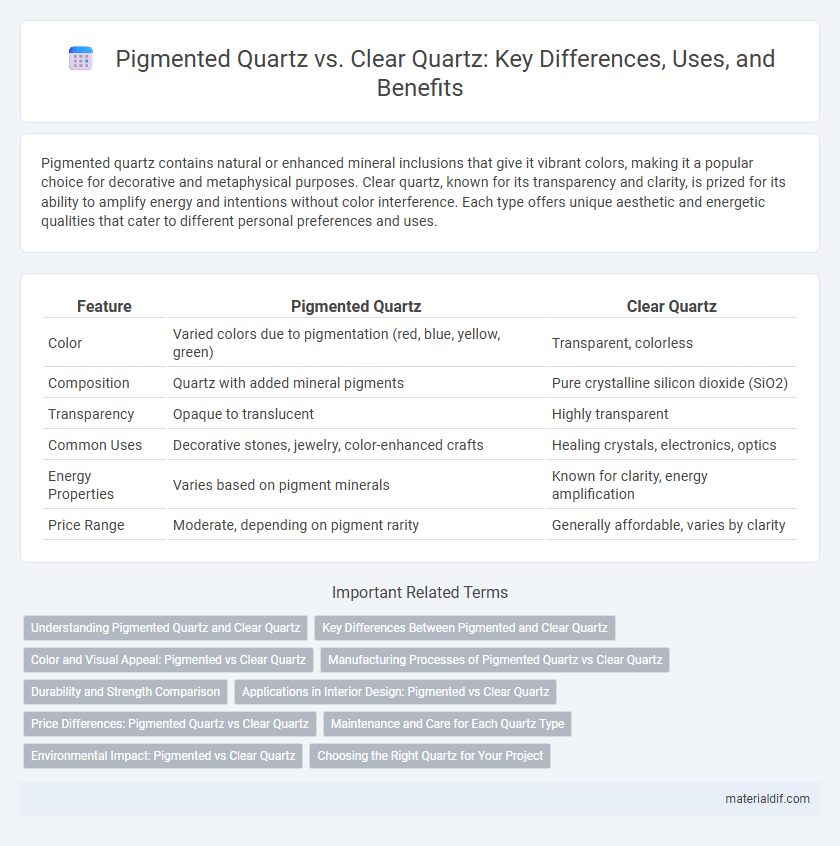Pigmented quartz contains natural or enhanced mineral inclusions that give it vibrant colors, making it a popular choice for decorative and metaphysical purposes. Clear quartz, known for its transparency and clarity, is prized for its ability to amplify energy and intentions without color interference. Each type offers unique aesthetic and energetic qualities that cater to different personal preferences and uses.
Table of Comparison
| Feature | Pigmented Quartz | Clear Quartz |
|---|---|---|
| Color | Varied colors due to pigmentation (red, blue, yellow, green) | Transparent, colorless |
| Composition | Quartz with added mineral pigments | Pure crystalline silicon dioxide (SiO2) |
| Transparency | Opaque to translucent | Highly transparent |
| Common Uses | Decorative stones, jewelry, color-enhanced crafts | Healing crystals, electronics, optics |
| Energy Properties | Varies based on pigment minerals | Known for clarity, energy amplification |
| Price Range | Moderate, depending on pigment rarity | Generally affordable, varies by clarity |
Understanding Pigmented Quartz and Clear Quartz
Pigmented quartz contains trace minerals or impurities that give it distinct colors such as purple, yellow, or pink, distinguishing it from clear quartz, which is pure silicon dioxide and transparent. The coloration in pigmented quartz often results from elements like iron, manganese, or titanium influencing its crystal lattice. Clear quartz, prized for its clarity and energy amplification properties, serves as a powerful conduit in metaphysical practices, whereas pigmented quartz is valued for both its aesthetic appeal and specific energetic attributes linked to its unique pigmentation.
Key Differences Between Pigmented and Clear Quartz
Pigmented quartz contains trace elements or mineral inclusions that give it vibrant colors, such as amethyst's purple hue or citrine's yellow tint, while clear quartz is nearly colorless and highly transparent. The presence of these impurities in pigmented quartz influences its optical properties and energy characteristics, making it popular in metaphysical applications for specific healing purposes. Clear quartz is valued for its versatility and clarity, often used to amplify energy or intentions without altering its energetic signature.
Color and Visual Appeal: Pigmented vs Clear Quartz
Pigmented quartz features vibrant hues caused by trace minerals such as iron, titanium, or manganese, providing a wide spectrum of colors from deep reds to greens and purples. Clear quartz, known for its transparent and colorless appearance, offers a versatile and pure visual appeal favored in jewelry and decor. The distinct color saturation in pigmented quartz enhances its aesthetic uniqueness, while clear quartz's clarity emphasizes light refraction and subtle elegance.
Manufacturing Processes of Pigmented Quartz vs Clear Quartz
Pigmented quartz manufacturing involves integrating colorants like metal oxides during the melting or sintering phases, enhancing aesthetic appeal without compromising structural integrity. Clear quartz production emphasizes purity and transparency, requiring meticulous removal of impurities through controlled heating and chemical treatments. Both processes utilize high-temperature crystallization techniques, but pigmented quartz demands precise pigment dispersion to achieve uniform coloration.
Durability and Strength Comparison
Pigmented quartz contains natural or treated color minerals, which can slightly affect its molecular structure, but it generally maintains similar hardness and durability to clear quartz, rated 7 on the Mohs scale. Clear quartz is highly durable and resistant to scratches and fractures, making it ideal for various industrial and decorative applications. Both types exhibit excellent strength, but pigmented quartz may show minor variations in durability due to impurities introduced during pigmentation.
Applications in Interior Design: Pigmented vs Clear Quartz
Pigmented quartz offers vibrant colors and unique patterns that enhance accent walls, countertops, and decorative elements, bringing warmth and personality to interior spaces. Clear quartz provides a sleek, translucent aesthetic ideal for minimalist designs, allowing natural light to diffuse and create an open, airy ambiance. Both materials are durable and versatile, with pigmented quartz emphasizing bold statements and clear quartz supporting subtle elegance in interior design applications.
Price Differences: Pigmented Quartz vs Clear Quartz
Pigmented quartz, such as amethyst or rose quartz, typically commands higher prices than clear quartz due to its unique coloration caused by trace minerals. Clear quartz is often more affordable and abundant, making it a popular choice for budget-conscious buyers and large-scale industrial applications. Price variations also depend on clarity, size, and quality, with pigmented varieties often prized for their rarity and aesthetic appeal.
Maintenance and Care for Each Quartz Type
Pigmented quartz requires gentle cleaning methods to preserve its color intensity, avoiding harsh chemicals that can cause fading or damage. Clear quartz is more resilient to cleaning agents but should still be wiped with a soft cloth to prevent scratches and maintain its clarity. Both types benefit from regular dusting and storage away from direct sunlight to extend their visual appeal and structural integrity.
Environmental Impact: Pigmented vs Clear Quartz
Pigmented quartz often requires the addition of dyes or chemical treatments, increasing its environmental footprint compared to clear quartz, which is typically processed with minimal modification. Mining clear quartz tends to have a lower ecological impact, as it undergoes less intensive refinement, reducing energy consumption and chemical waste. Choosing clear quartz supports more sustainable practices by limiting the use of potentially harmful pigments and reducing the carbon emissions associated with pigment production.
Choosing the Right Quartz for Your Project
Pigmented quartz offers vibrant colors ideal for decorative projects requiring a unique aesthetic, while clear quartz provides maximum clarity and versatility for applications needing purity and light transmission. Selecting the right quartz depends on the project's visual and functional requirements, such as color intensity versus optical clarity. Consider pigmented quartz for artistic or design-focused uses and clear quartz for technical or minimalist projects.
Pigmented Quartz vs Clear Quartz Infographic

 materialdif.com
materialdif.com